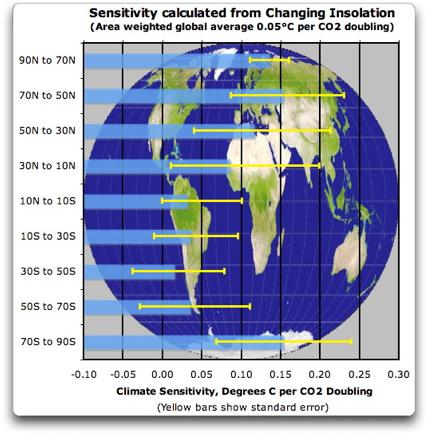Is Willis Wrong at WUWT? or Sensitivity and Sensibility I
Posted on 7 July 2010 by MarkR
Guest post by Mark Richardson
Willis Eschenbach at Wattsupwiththat has invented a way to calculate climate sensitivity – how much temperatures go up when you heat Earth. He takes changes in temperature and sunlight between summer and winter for each latitude then divides one by the other and concludes that if you doubled CO2 on Earth, temperatures would rise ~0.05 oC. The IPCC reckons 2-4.5 oC and Willis thinks they’re wrong because thunderstorms cancel out the heating. Wow!

Figure 1 – Climate sensitivities in oC per CO2 doubling based on assuming that regional winter-summer changes in sunshine and temperature have the same relationship as changing CO2 globally over centuries.
Willis’ 3 obvious mistakes are that he isn’t calculating any of the IPCC’s climate sensitivities (neither equilibrium, effective nor transient), that regional and global heating are different, and that 6 months is a short time.
Here’s all 3 in action: yesterday London changed 14 oC from day to night whilst sunlight changed about 750 W m-2 which gives ~0.07 oC warming for a CO2 doubling. Is this because of thunderstorms, or because you’re looking at one place for too short a time? Thought experiments should help explain the physics behind this sleight of hand.
The ball in a box
Imagine a ball in a vacuum with two lights shining on it from opposite sides. If you turn up both lights then the ball warms up until it gives out enough extra infrared to cancel out the heating. This is where the textbook value of ~1 oC warming for doubling CO2 without feedbacks comes from (Lorius 1990).
On the other hand, if you turn one light up and one down by equal amounts and the sphere is a perfect thermal conductor then as soon as one side heats up it conducts the heat to the other side and the sphere won’t change temperature at all. Willis reckons that you can measure the change in temperature and light on one side and then calculate the ‘sensitivity’ of the whole sphere to be zero: which is wrong.
The kettle and the clock
Sometimes climate sensitivity is estimated from quick changes like volcanic eruptions (e.g. Forster and Gregory or Yokohata et al), but they account for how Earth is still heating up in such short times.
Imagine you turn on a kettle & hold the button down for hours. The water boils off and you report that the water is sensitive to the kettle. Your friend turns on the kettle for 10 seconds then measures the temperature change and reports that your claim of kettles boiling water is ‘a cruel joke.’
Heat flows and sensitivity
The 2-4.5 oC warming for doubled CO2 (IPCC 2007) is the equilibrium value – once Earth has warmed up so that heat in equals heat out.
Looking at the short term means you haven’t seen all of the heating: just like the kettle you only turned on for 10 seconds. If you measure a lot of heat going into the atmosphere and oceans then you’re far from equilibrium and underestimating sensitivity.
If you only look at one region and lots of extra heat is being transferred to another region, like with the conducting ball, you’ll see less warming and you’ll underestimate sensitivity.
In part II we’ll look at how much heat is stored during summer or moves around throughout the year.































 Arguments
Arguments























 0
0  0
0






Comments